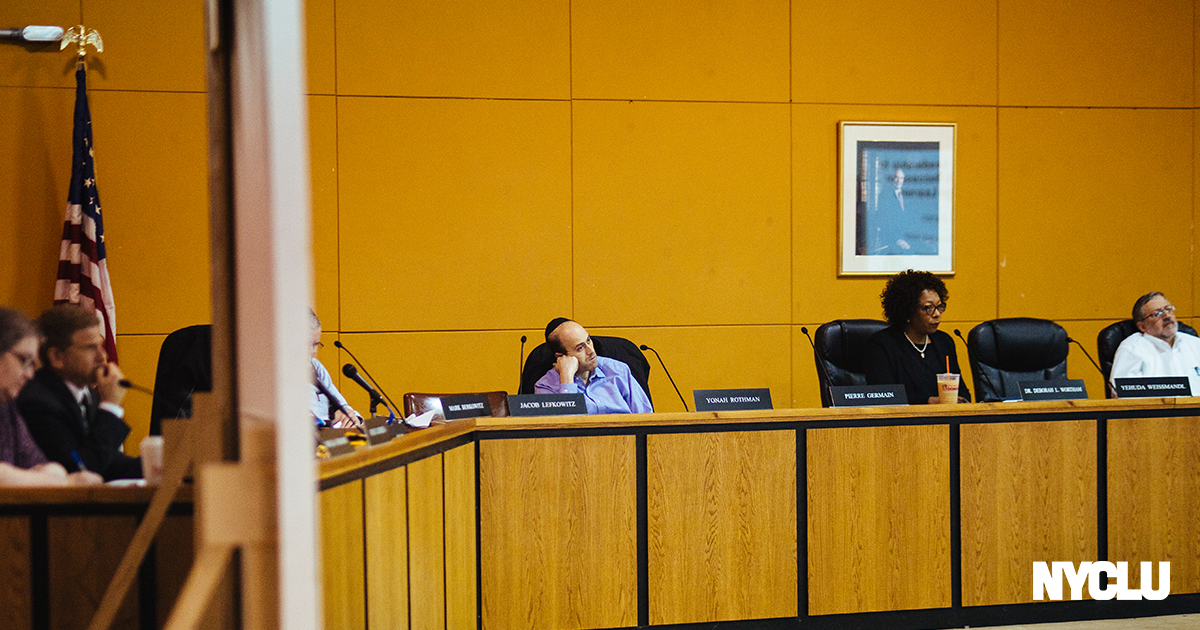Why is NY’s Onondaga Nation School Crumbling?
Civil Liberties Union

The NYCLU is in federal court this week challenging the winner-take-all at-large voting system for electing school board members in the East Ramapo Central School District. This system denies Black and Latinx voters in the District an equal opportunity to elect their candidates of choice to the school board, and has allowed the white community – which doesn’t send their kids to the public schools – to hijack the board and decimate the once highly acclaimed East Ramapo public schools. The board has slashed funding, cut essential school programs and services, and diverted millions of public-school funds to the nearly all-white private schools.
We argue that the at-large election scheme – under which all board members are elected on an at-large basis by all the voters of the District rather than representing each community within the District – violates the federal Voting Rights Act. Historically, at-large voting schemes like this were a favorite tool of segregationists in the South to prevent Black citizens from gaining a voice in government.
To ensure Black and Latinx voters have an equal opportunity to elect candidates who truly represent them, the NYCLU is asking the court to order the school board to establish a ward system that would allow voters to choose representatives from geographically defined neighborhoods.
As the trial started this week, the NYCLU and lawyers from Latham & Watkins LLP opened our case with voting rights experts who describe how the East Ramapo election system disenfranchises people of color.
Dr. Matt Barreto, a voting rights expert and political science professor at UCLA, laid out the specific problems with the East Ramapo election system.
Dr Barreto and his colleague, Dr. Loren Collingwood, used several different methods to analyze every contested School Board election in East Ramapo from 2013 to 2018 to determine whether there is racially polarized voting in the elections.
No matter how you look at it, the evidence was clear: White people were voting as a bloc and voting for different candidates than Black and Latinx voters. And in every election, candidates supported by Black and Latinx voters lost.
The combination of at-large elections and racially-polarized voting produces a situation where a cohesive white majority can effectively determine the winner of all board seats. In East Ramapo, that has meant candidates can only win if they are preferred by white voters.
In East Ramapo, that has meant candidates can only win if they are preferred by white voters.
The East Ramapo School Board opened three new polling locations in 2018 to make voting more convenient – but much more so for white voters. Drs. Barreto and Collingwood analyzed the new polling locations and found that at the new locations the vast majority of votes went to white-preferred candidates. Indeed, their analysis showed that, as a general matter, polling places in East Ramapo tend to be more convenient for white voters than for Black or Latinx voters.
At the same time, the total number of polling places for East Ramapo School Board elections was relatively small. Dr. Barreto testified that the thirteen polling places for school board elections is substantially fewer than the 20 polling places that are open for state and federal elections in that area.
Dr. Barreto testified that the timing of School Board elections could drive down voter turnout, particularly for people of color. In East Ramapo, elections are held on the third Tuesday in May, not the same day as any other elections. Not surprisingly, turnout is far lower.
Dr. Barreto said turnout among Black voters tends to be disproportionately low in off-cycle local elections. One reason is that elections held at odd times force potential voters to bear additional costs to participate in the political process. An employer is required to provide time off to vote on Election Day in November, for example, but there is no such requirement for elections in May.
As the burdens of voting increase, voters who believe their votes don’t count – because they are unable to elect their representatives of choice – tend to opt-out.
Dr. Barreto testified that there is a slating process, where the white community puts forward a slate of candidates who represent the interests of the white community. Black and Latinx people are cut out of the vetting and selection process for this slate.
Instead, white community leaders in the private school community recruit, endorse, and ensure the election of their preferred candidates.
All of the factors laid out by Dr. Barreto combine to create a toxic mix that unlawfully dilutes the votes of the Black and Latinx residents, discourages them from voting, and denies them representation on the East Ramapo school board.
Our lawsuit demands that the at-large voting method be replaced by a ward system with nine single-member districts, which permits voters living in each ward to elect their own Board member. That will give Black and Latinx voters a meaningful voice in these elections.
**STAY TUNED: Next we’ll explain the decimation of the East Ramapo public schools by an un-representative school board**